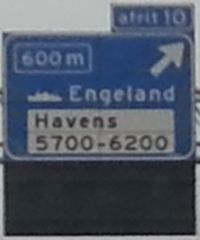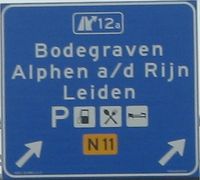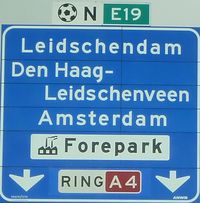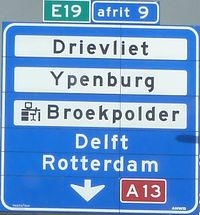Proposal:Destination details
|
The proposal Additional subkeys for the destination key was built without a vote and the tagging is widely established based on this proposal. The Feature Page for the proposal Additional subkeys for the destination key is located at Key:destination:symbol. |
| Additional subkeys for the destination key | |
|---|---|
| Proposal status: | Abandoned (inactive) |
| Proposed by: | imagic |
| Tagging: | destination:ref=* destination:symbol=* destination:country=* destination:lang=* |
| Applies to: | |
| Definition: | Additional subkeys to the established key destination=* to provide further details |
| Draft started: | 2012-10-19 |
| RFC start: | 2012-10-19 |
| This proposal is currently set to "inactive" because no further discussion is going on. Nevertheless, all keys proposed here are in widespread use. |
Currently the key destination=* describes the direction of the highway by using the name of the city the highway is heading to. Additional sub-keys should be introduced to provide further information like the reference of the road ahead, the country the road is heading to or a special symbol like for an airport.
Rationale
In order to present accurate and precise instructions, a navigational device needs information about the road it should lead the driver to. The established key destination=* only describes the name of a city or place.
The photo on the right shows a typical signpost on a motorway. Beside the name of major cities it also displays:
- the reference of the roads: A5, S1 and A2
- the countries the roads are heading to: CZ, SK, H, SLO, I
- a symbol of an aeroplane, identifying the road which is leading to the nearest airport
Tagging
Just like the key destination=*, all sub-keys should be put on the first way after the junction. On the way before the junction those keys should (additionally!) only be used if their values are lane-dependent, and then the suffix :lanes has to be added.
All the sub-keys should only be used to specify information that can be seen on signposts, road markings or similar.
destination:ref
The key destination:ref=* should be used to specify the reference of the roads directly ahead as indicated on signposts, road markings or similar. The value of this key should be equal to, or a further qualification of, the value of the key ref=* of these roads.
destination:ref:lanes
The key destination:ref:lanes=* (or destination:ref:lanes:forward=* and destination:ref:lanes:backward=*) should be used to specify the reference of the lanes directly ahead as indicated on signposts, road markings or similar. The value of this key should be equal to the value of the key ref=* these lanes lead to.
destination:ref:to
The key destination:ref:to=* should be used to specify the reference of a major highway ahead, as indicated on signposts, road markings or similar. This is a common practice in the United States on motorway destination signs, see [1]. The value of this key should NOT be equal to the value of the key ref=* of these roads, because a destination:ref:to=*'s reference road will never directly connect to the slip road indicated on the sign; it is provided as a means of navigational assistance to the driver.
destination:int_ref
The key destination:int_ref=* should be used to specify the international reference of the roads ahead ahead as indicated on signposts, road markings or similar. The value of this key should be equal to the value of the key int_ref=* of these roads.
destination:country
The key destination:country=* should be used to specify the country a road is leading to. Valid values are usually international licence plate country codes.
destination:symbol
The key destination:symbol=* should be used to indicate that a special symbol/icon is present on a signpost, visible as road marking or similar.
| Tag | Symbol examples | United States | Canada | France | Leading to |
|---|---|---|---|---|---|
| Table has been relocated to main page of destination:symbol=* as proposal itself became abandoned. | |||||
destination:lang:<language code>
In some countries the names of cities are written in more than one language. The name(s) in the official language should be put into the destination=*. Those in different languages should be put into destination:lang:<language code>=*. Possible values for language code are - as usually - ISO 639.1 codes.
In many countries with non-Latin alphabet names are sometimes shown in Latin alphabet additionally. In such case the actual language of the name written in Latin may not be clear. It is recommended to choose the most widely used language in the world, in which the name is written exactly as shown on the signpost; in many cases this will be English (language code: en).
destination:street
If a signpost contains a street name, use this tag.
If the street is displayed in multiple languages, use a language qualifier as described in the header Consider this example:
The destination tagging for this signpost would be:
- destination:street:lang:fr=Rue Regent Sud
- destination:street:lang:en=Regent Street South
- destination:ref:=101 South
- destination:=New Maryland
On the Canadian mailing list the destination:street:fr=* was proposed, but destination:street:lang:fr=* fits better to existing tags and avoids ambiguities (Is ':to' a language name or not?). There are still about 200 cases of the first scheme in the database (solely for English and Arabic), while the majority of keys and languages use the ":lang" scheme.
Examples
| Photo | Tags | Note |
|---|---|---|

|
destination=Λάρισα;Κοζάνη destination:lang:en=Larisa;Kozani destination:symbol=;airport destination:ref=A 27 destination:int_ref=E 65 |
On this sign the cities the road is heading to are written in two different languages. |

|
destination=Brno;Poysdorf;Mistelbach destination:ref=A5 destination:country=CZ |
This sign also contains the country the road is heading to. |

|
destination=Wien;Altmannsdorf;Inzersdorf destination:symbol=centre;; |
A symbol for the centre of the city is present. |

|
destination=Engeland;Havens 5700-6200 destination:symbol=ferry; |
A symbol for the ferry to England is present. |

|
destination=Hessenpoort;Ommen;Dalfsen;Hardenberg destination:symbol=industrial;;; destination:ref=N340 |
A symbol for the industrial zone is present. |

|
destination=Bodegraven;Alphen a/d Rijn;Leiden destination:symbol=;;;parking,fuel,restaurant,lodging destination:ref=N11 |
Symbols for the parking, fuel, restaurant and hotel are present. |

|
destination=Andere richtingen destination:ref=Randweg N2 |
The word 'Randweg' (bypass) is part of the destination:ref tagging. |

|
destination=MMC Veldhoven;Veldhoven-Zuid;Veldhoven;6500-8500 destination:symbol=hospital;;;industrial destination:ref=Randweg N2 |
Symbols for the hospital and the industrial zone are present. |

|
destination=N;Leidschendam;Den Haag-Leidschenveen;Amsterdam;Forepark destination:symbol=soccer_stadium;;;;industrial destination:ref=A4 destination:int_ref=E 19 |
Symbols for the soccer stadium and the industrial zone are present. |

|
destination=Centraal Station;Rotterdam (A4);Utrecht;Amsterdam (A4) destination:symbol=covered_parking destination:ref=A12 |
A symbol for the covered parking is present. |

|
For the "left" road: destination=Düsseldorf destination:symbol=motorway destination:ref=A59 |
A symbol for the next motorway is present. |
| The following example is based on the lanes-extension and should be used before the junction. | ||

|
destination:lanes=Transferium Westraven;Kanaleneiland;Jaarbeurs;Centrum|Jaarbeurs;Centrum destination:symbol:lanes=park_and_ride|none |
A symbol for the park & ride is present. |
| Alternative tagging for (near) photorealistic view of signposts using different tags. Please comment on this. | ||

|
destination:int_ref=E 19 junction:ref=9 destination=Drievliet;Ypenburg;Broekpolder;Delft;Rotterdam destination:symbol=;;commercial;; destination:ref=A13 |
A symbol for the commercial zone is present. |
Common questions
destination_ref vs. dest_ref vs. destination:ref
At the time of this proposal the keys destination_ref=* and dest_ref=* have been already used for the purpose of the proposed destination:ref=*. Both keys are not documented (and quite a lot of destination_ref tags are from me). As the usage numbers currently are not too high (about 400-500 each) I still recommend to use the key destination:ref=* instead to introduce a consistent tagging scheme with all the other sub-keys. Please use the Discussion page to comment on this.
Update on Dec 12th 2012: This issue is more or less obsolete: current usage numbers are 1381 (destination:ref) vs. 263 (destination_ref) vs 219 (dest_ref).
Update un Dec 14th 2013: Issue is obsolete. Both dest_ref=* and destination_ref=* are no longer used for ways. (destination_ref=* is still being used several times for Relation:destination sign and should be changed to ref=* in that context, but that will have to be discussed and solved there and not here.)
destination:sign vs. destination:symbol
When writing the proposal I originally proposed the key destination:sign=*. After some comments it was clear that the word sign is ambiguous and the key was changed to destination:symbol=*.
Comments
Please use the Discussion page for this.
See also
- A summary of all destination-related tags that are in use, independent of their status
- OSM Destination Signs - Rendering of signs based on destination=* and Relation:destination_sign.
- CheckAutopista – Rendering and check of destination=*, destination:ref=*, destination:int_ref=* and destination:symbol=* for motorway exits.
- destination:symbol=* (German wiki page)
- User:Minh Nguyen/destination:street – clarification on when to use destination:street=*

